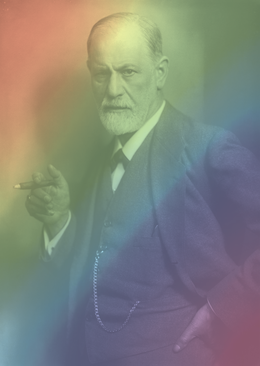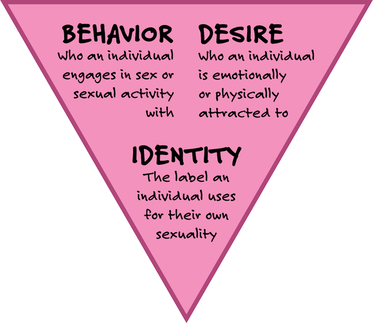|
11/1/2020 2 Comments Sigmund Freud: A Queer ReadingDyanna Bateman (she/her)Sigmund Freud. This is a name that many have heard, remembered, and associated with oddly-specific theories about sex. But, what does Freud have to do with sexuality, specifically LGBQ+ sexualities?  Sigmund Freud posing for a picture with a slight rainbow gradient. Photo edited by Dyanna Bateman. Sigmund Freud posing for a picture with a slight rainbow gradient. Photo edited by Dyanna Bateman. Before Freud, our only ideas of sex came from Classic Era Sexology, which was developed in the mid- to late-1800s in Western Europe and the United States. Famous sexologists like Richard von Krafft-Ebing, Havelock Ellis, and Magnus Hirschfield normalized the ideas that humans were born with a sexual nature that was at the core of humanity; it was considered as basic as eating and sleeping. This innate nature motivated human behavior and was naturally expected between a man and woman because of principles of opposite attraction and compatible reproduction. Anything outside of these specific circumstances, including sexual pleasure of any kind, was considered perverse. Freud’s major works appeared around 1905 to 1930 and completely rebranded the conversation around sexual nature. This in turn ignited discourse for non-reproductive and for pleasure sexual encounters. Freud introduced the idea of sex instinct as a composite drive with various motivations, rather than reproductive expectations. He introduced the idea of sex for pleasure, satisfaction, and exploration, in addition to the reproduction foundation created by Classic Era Sexology. Freud also published that humans were born with the capacity for many forms of pleasure. He called this “polymorphous perverse” and normalized the idea of various erogenous zones. Erogenous zones are areas of the body that are associated with heightened sensitivity that causes some form of satisfaction after stimulation. Freud’s work identified many areas that were able to generate pleasurable responses, including the mouth and genitalia. Both of these ideas were considered against common knowledge in the early 20th century, but Freud continued to create more.  A conceptualization chart of behavior, identity, and desire (BID) packages. Infographic by Dyanna Bateman. A conceptualization chart of behavior, identity, and desire (BID) packages. Infographic by Dyanna Bateman. Freud described sex as both a phyiscal and mental experience that combined actions with fantasies and thoughts, which is very reminiscent of modern day behavior, identity, and desire (BID) packages for sexuality. Sex was given a societal meaning that could be shaped and constrained by complexes of sexual morality and individual opinion. Most influential to our current understanding of sexuality, Freud used object choice as a definition of sexual personhood. Object choice is the study of why an individual chooses to interact with another individual on romantic or sexual terms. By introducing object choice as the defining characteristic, Freud created an environment that allowed for LGBQ+ identities. Our modern-day usage of terms like gay, lesbian, bisexual, queer, and many others did not exist in the same way in Freudian time, but by redefining sex as an object choice, Freud laid the foundations for these identities to be formed. A relationship did not have to be a male-reproductve system with sperm and a female-reproductive system with eggs; the possibility allowed for attraction to the erotic idea of masculinity or femininity which has been mapped on to all modern day sexualities (including heterosexuality). Even though his theories have influenced the way that we conceptualize sexuality and identity, it’s important to note that Freud was not actually tolerant of LGBQ+ identities. Freud did not believe that homosexuality was an illness, like much of his collegaues in psychoanalysis, but he did refer to same-sex attraction as a stunted growth and psychological immaturity. He had no issue about talking about homosexuality, but did not promote LGBQ+ identities as valid. Sources: “Social Construction of Sexuality” by Steven Seidman and “SOC 345: Sociology of Sexualities” lectures by PJ McGann at the University of Michigan
2 Comments
Chelle Jones
11/17/2020 12:32:05 am
This is fantastic!
Reply
PJ McGann
11/18/2020 02:27:21 pm
LOVE IT!!!!
Reply
Leave a Reply. |
Search by typing & pressing enter
